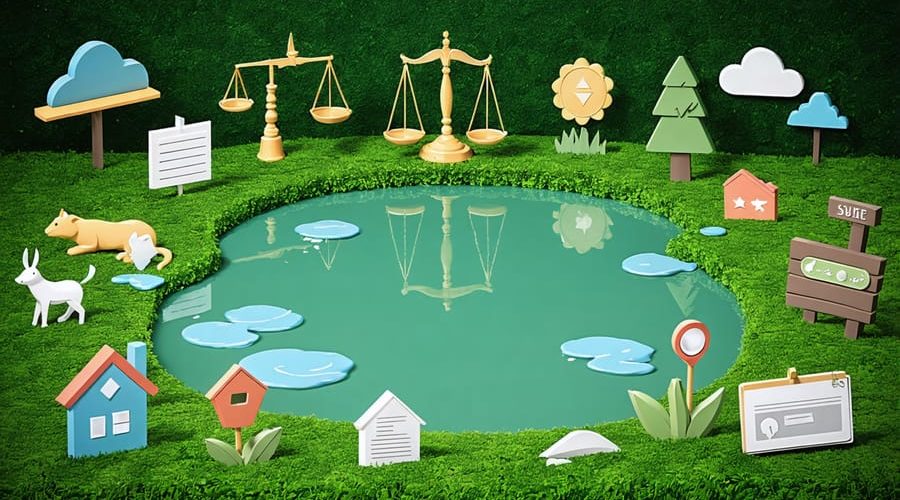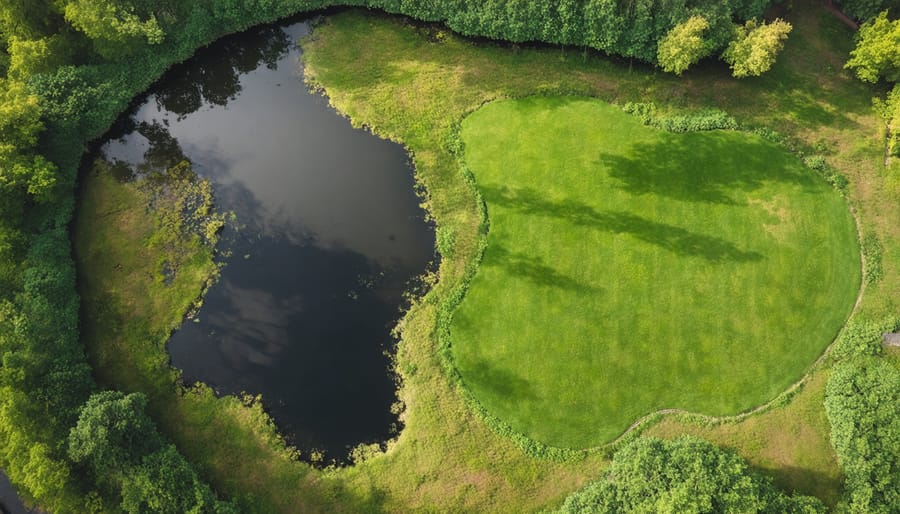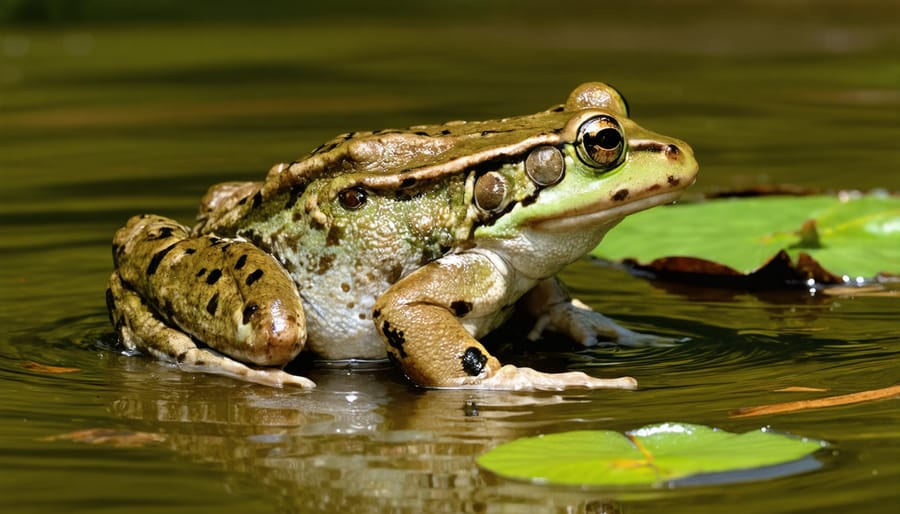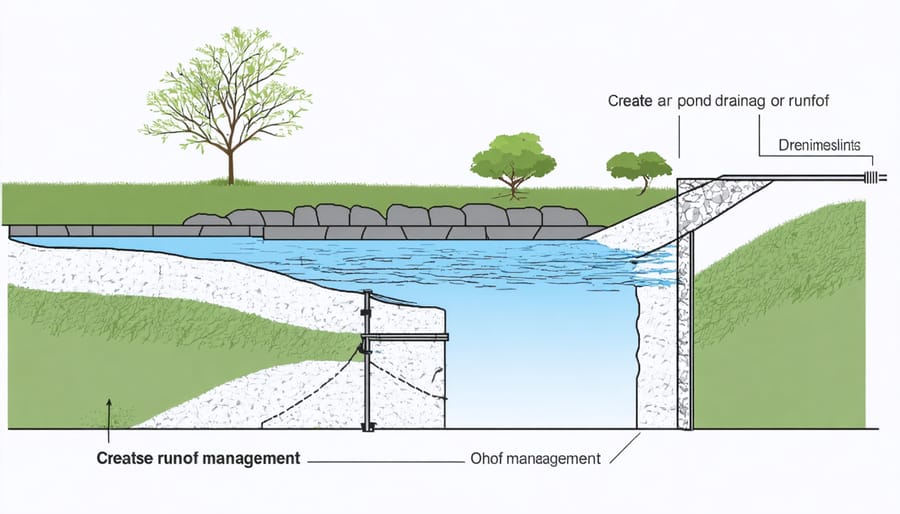
Essential Pond Laws That Keep Your Water Garden Safe and Legal
Building a pond involves navigating complex legal requirements that protect both property rights and natural ecosystems. From local zoning laws to federal wildlife regulations, understanding “pond law” safeguards your investment and prevents costly violations. Recent environmental protection measures have made pond ownership more regulated than ever, with specific requirements for water rights, wildlife protection, and watershed management.
Whether you’re planning a backyard water feature or managing a large recreational pond, compliance with pond-related laws is essential. Key legal considerations include property boundaries, water usage rights, dam safety regulations, and endangered species protection. Many states now require permits for ponds exceeding certain sizes or those connected to natural waterways.
The legal framework surrounding pond ownership balances private property rights with environmental stewardship. Pond owners must consider:
– Water rights and downstream impacts
– Fish and wildlife regulations
– Liability and safety requirements
– Maintenance and water quality standards
Understanding these legal requirements before breaking ground prevents future complications and ensures your pond enhances both your property and the local ecosystem. This guide explores the critical legal aspects of pond ownership, maintenance, and compliance with current regulations.
Property Laws and Pond Ownership
Boundary and Access Rights
When it comes to pond ownership, understanding boundary rights and access issues is crucial for maintaining good neighborly relations. Your pond’s boundaries should be clearly marked and documented in your property deed. If your pond shares a boundary with neighboring properties, both parties typically have equal rights to the water body, unless specifically stated otherwise in legal documents.
For shared ponds, it’s important to establish written agreements about maintenance responsibilities, access rights, and usage limitations. These agreements can prevent future disputes and ensure everyone understands their rights and obligations.
Even if your pond is entirely on your property, you should consider installing appropriate fencing or barriers to prevent unauthorized access. This not only protects your liability but also ensures the safety of others, especially children who might be attracted to the water feature.
Remember that natural water sources like streams or springs feeding your pond might be subject to different regulations. Some states require you to allow reasonable access to natural water sources, even if they flow through private property. Always check local ordinances and consider consulting a property lawyer to understand your specific rights and responsibilities regarding pond boundaries and access.

Liability Considerations
As a pond owner, you have a legal responsibility to ensure your water feature doesn’t become a safety hazard. This includes taking reasonable precautions to protect your family and visitors from accidents. Installing proper fencing, especially if your pond is deeper than 18 inches, is often required by local ordinances.
You may be liable for injuries that occur if someone falls into your pond, particularly if you haven’t taken adequate safety measures. This applies to both invited guests and, in some cases, unauthorized visitors – especially children who might be attracted to the water feature (known as an “attractive nuisance” in legal terms).
Consider installing safety features like:
– Secure fencing with self-closing gates
– Warning signs
– Proper lighting around the pond
– Non-slip surfaces on walkways
– Life-saving equipment nearby
It’s also wise to review your homeowner’s insurance policy to ensure it covers pond-related incidents. Many policies require specific riders for water features. Regular maintenance and prompt repairs of any safety features are essential to demonstrate your commitment to reasonable care and potentially protect you from liability claims.
Wildlife Protection Requirements

Protected Species Regulations
When creating a pond, it’s crucial to consider the impact on local wildlife and protected species. Many regions have strict regulations about protecting native wildlife, particularly endangered species that might make your pond their home.
Before making any changes to an existing pond or building a new one, check with your local wildlife authority about protected species in your area. You may need special permits if your pond could affect the habitat of endangered amphibians, fish, or aquatic plants. Many jurisdictions require property owners to maintain specific conditions if protected species are present.
Common protected species include certain types of frogs, salamanders, and freshwater fish. If these creatures establish themselves in your pond, you may be legally required to maintain their habitat. This might mean avoiding certain chemicals, maintaining specific water levels, or preserving particular plants they need for survival.
It’s also important to note that some areas restrict the removal or relocation of protected species once they’ve made your pond their home. While this might seem challenging, having protected species in your pond can actually be beneficial – they often help maintain the natural balance of your ecosystem and can make your water feature more interesting and environmentally valuable.
Remember to document any protected species you find and keep records of the measures you take to protect them. This can be helpful if you need to demonstrate compliance with local regulations.
Seasonal Considerations
When it comes to managing your pond, being aware of seasonal legal requirements is crucial, especially during breeding and migration periods. Many pond owners don’t realize that these natural cycles come with specific responsibilities under wildlife protection laws.
Spring and early summer are particularly sensitive times, as many amphibians and waterfowl use ponds for breeding. During these months, it’s generally illegal to disturb nesting areas or remove aquatic vegetation that might serve as habitat. If you need to conduct maintenance, it’s best to schedule major work between late fall and early winter.
For ponds that attract migratory birds, federal laws protect these visitors during their seasonal movements. You’ll need to be extra careful about any changes to your pond between March and July, and again from September to November. Even simple activities like cleaning or reshaping might need to be postponed during these periods.
Some regions require special permits for pond work during breeding seasons. It’s always wise to check with your local wildlife authority before starting any significant maintenance projects. They can provide specific dates for your area and guide you through any necessary paperwork.
Remember that these seasonal restrictions aren’t meant to be burdensome – they’re designed to protect the delicate balance of our ecosystem while still allowing you to enjoy your pond throughout the year.
Water Rights and Management
Water Source Regulations
Before creating a pond, it’s essential to understand the regulations governing water sources and usage in your area. Most jurisdictions require permits for collecting and using water, especially if you plan to draw from natural sources like streams or groundwater. These regulations protect both the environment and other water users’ rights.
For residential ponds, you’ll typically need to work with your local water authority to ensure compliance with water collection rules. Some areas restrict the amount of rainwater you can collect, while others encourage it through incentive programs. If you’re planning to use well water, check your local ordinances regarding extraction limits and water quality management requirements.
Many regions have specific guidelines about water discharge and overflow management. You may need to implement proper drainage systems to prevent excess water from affecting neighboring properties. Additionally, some areas require regular testing of pond water, particularly if it connects to natural waterways or could impact local wildlife.
Remember that water rights can vary significantly by location, so it’s crucial to consult your local water authority or municipality before starting your pond project. They can provide detailed information about permitted water sources, usage limits, and any necessary documentation.

Runoff and Drainage Laws
Managing runoff and drainage from your pond isn’t just about keeping your property dry – it’s a legal responsibility that affects your neighbors and local environment. Most jurisdictions require pond owners to ensure their water features don’t create flooding issues for adjacent properties. This means you’ll need to implement proper overflow systems and maintain them regularly.
A key legal requirement is the “reasonable use” doctrine, which states that while you can make changes to natural drainage patterns on your property, you can’t significantly increase water flow onto neighboring land. Many areas require a drainage plan before pond construction, showing how excess water will be handled during heavy rains and spring thaws.
You’ll also need to consider local regulations about water retention and stormwater management. Some communities require ponds to serve as retention basins during heavy rainfall, while others restrict this practice. It’s essential to install appropriate spillways and drainage systems that meet local code requirements.
Remember that drainage laws can vary significantly by location, and what’s permitted in one area might be prohibited in another. Always check with your local water management authority before making any changes to your pond’s drainage system, and keep detailed records of your compliance efforts.
Fish and Aquatic Life Regulations
Permitted Species
When introducing fish species to your pond, it’s crucial to follow local regulations that protect native ecosystems. Most jurisdictions require permits for certain fish species, while others may be completely prohibited. Before stocking your pond, check with your local fish and wildlife department for an updated list of permitted species.
Common approved species typically include ornamental fish like koi and goldfish for decorative ponds. For larger natural ponds, native species are usually preferred and often recommended by environmental agencies. When protecting pond fish, ensure you’re not only following safety measures but also adhering to species regulations.
It’s important to note that invasive species are strictly prohibited in most areas. These restrictions exist to prevent ecological damage to local waterways and protect native wildlife. Some regions require special licenses for breeding certain fish species, particularly if your pond connects to natural water bodies.
Keep detailed records of your fish population and their origins. Many jurisdictions require documentation proving that your fish were legally obtained from licensed suppliers. Some areas also mandate regular inspections to ensure compliance with species regulations.
Remember that regulations can change, so stay informed about updates to local pond laws. Consider joining local pond owners’ associations to keep up with current guidelines and best practices for managing permitted species in your water feature.
Disease Control Requirements
Keeping your pond healthy isn’t just good practice – it’s often a legal requirement. Many regions require pond owners to monitor and control diseases that could affect fish and other aquatic life. This helps protect both your pond’s ecosystem and neighboring water bodies.
Most jurisdictions mandate immediate reporting of any suspected fish diseases to local agricultural or environmental authorities. If you notice unusual behavior, unexplained deaths, or visible signs of illness in your fish, you’re legally obligated to notify the proper agencies. They’ll help identify the problem and guide you through necessary treatment protocols.
Regular testing of water quality is another common requirement. Many areas specify minimum testing frequencies and particular parameters that must be monitored. Keep detailed records of your test results – these may be required during inspections or if problems arise.
When introducing new fish to your pond, you’ll likely need to follow quarantine procedures. Many regions require a isolation period of 2-4 weeks for new arrivals. This helps prevent the spread of diseases to existing pond inhabitants. Some areas also require health certificates for fish purchases, especially for certain species or quantities.
If disease outbreaks occur, you may be legally required to implement specific treatment measures. This could include using approved medications, adjusting water chemistry, or in severe cases, completely draining and sanitizing your pond. Some jurisdictions may also restrict water discharge during disease treatments to prevent contamination of natural waterways.
Remember to stay informed about local regulations, as disease control requirements can vary significantly between regions and may change over time. Regular consultation with local authorities can help ensure you’re meeting all necessary obligations.
Building and maintaining a pond on your property can be a rewarding experience, but it comes with important legal responsibilities. As we’ve explored throughout this article, understanding and following pond-related laws helps protect both your interests and the environment. Remember to always check local zoning regulations, obtain necessary permits, and maintain proper insurance coverage before starting your pond project.
Responsible pond ownership means staying informed about water rights, wildlife protection laws, and safety requirements. Keep detailed records of your permits, maintenance activities, and any interactions with local authorities regarding your pond. Regular monitoring of water quality and maintaining appropriate fencing or safety features not only keeps you compliant with regulations but also ensures a safe environment for your family and visitors.
Consider joining local pond owners’ associations or water gardening groups to stay updated on changing regulations and best practices. Building positive relationships with neighbors and being proactive about addressing potential concerns can help prevent legal disputes down the line.
Finally, remember that pond laws exist to protect our shared natural resources and ensure everyone’s safety. By following these guidelines and maintaining your pond responsibly, you can enjoy your water feature while being a good steward of the environment and a respectful member of your community. When in doubt, always consult with local authorities or legal professionals for specific guidance about your pond project.
